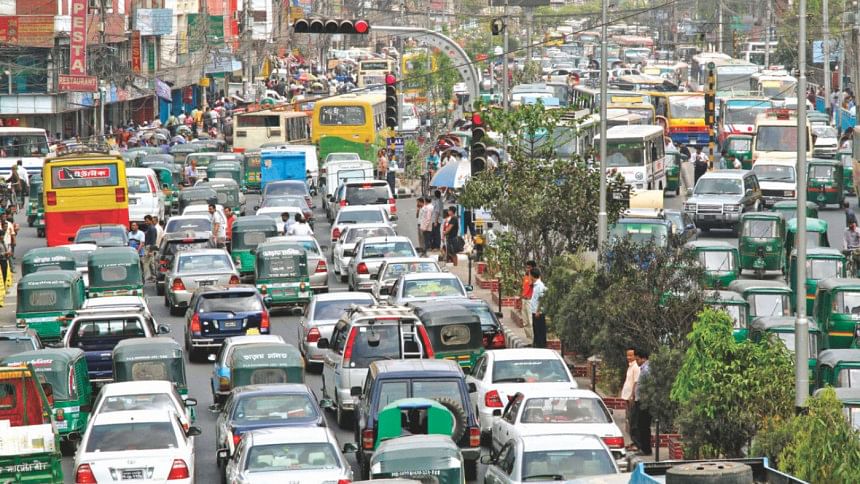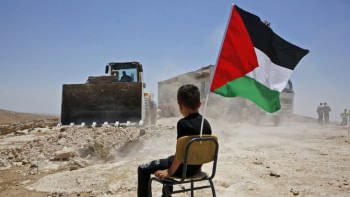Commuting woes

The main reason for road congestion, other than the huge number of rickshaws in most roads, is the number of motorised vehicles - about 7.5 lakhs - plying on the road. Dhaka is now one of the most densely populated cities of the world with a population density of nearly 31,000 per sq km covering 300 sq km of the DCC area. Many of these slow moving, non-mechanised vehicles contributed to the problem of traffic jam and congestion. With vehicle population booming every year, the roads have become pulverised, cratered and potholed, and for long stretches have been reduced to mere dirt tracks. A survey conducted in the recent past on vehicle movement, mostly cars and buses revealed that the average speed of a car or passenger bus was just 20 kmph. All the past governments took up ambitious plans such as construction of elevated expressways, flyovers and metro-rails in and around Dhaka. Dhaka dwellers are weary of such grandiose pledges because nothing has actually materialised so far.
Commuting in the city is just like buying a one way ticket to hell. In the present scenario, there is hardly any scope for widening roads, as experts suggest, because the planners in the past had hardly taken account of the potential dimension this city in the foreseeable future. Plainly speaking, Dhaka city has suffered in the hands of policy makers. What is apparent is that the crisis of governance is particularly marked at the utility providers' (DCC, Rajuk, Wasa, Btcl) level. Whereas urban governance demands a coherent, coordinated and vibrant set-up, Dhaka and most other cities appear to have been saddled with fragmented, fractured and imbecile authorities incapable of tackling core problems. While those who ravish the city and imperil its future get away with impunity, the law-abiding citizens suffer the consequences of traffic congestions and shortage of civic services that the illegal constructions and encroachments cause.
Given the unplanned growth of the city during the last 44 years, there is hardly any scope to improve the surface communication. In the present cataclysmic situation, efforts must be taken to introduce mass transportation systems through withdrawal of taxicabs, tempos and minibuses carrying fewer than 30 passengers on the main roads. Adoption of such measures could substantially reduce or ease up traffic congestion.
Other than the influx of new cars that are hitting the city roads, there is huge increase in the number of rickshaws, most of which are allegedly unlicensed and covering 22 sq ft per person compared to 8.7 sq ft occupied by a bus passenger. Private cars cover 160 sq.ft and carry at best four passengers. On busier intersections and at 10 rail crossings in the city, vehicles are caught in traffic snarls that often last about five to ten minutes at a stretch in one location and then consider the time lost for 74 trains leaving and entering Kamalapur rail station daily. The newly elected mayors of the two city corporations are frantically trying to solve Dhaka city's traffic congestion. Even switching on the electronic signal system a few days ago on a trial basis didn't yield the desired result because of technical glitches in the system, as reports revealed.
The major cause of congestions and road jams can be attributed to a lack of judicious land use or scarce road space of the city. The minimum road requirement for a standard city is 25 percent, whereas Dhaka city roads constitute 7.5 percent of its total area. On the other hand, hawkers create a lot of road congestion and road hazards in all parts of the busy city areas by encroaching not only pavements but also parts of the road. This has resulted from DCC's failure to rehabilitate these hawkers in a business–friendly area.
On the other hand, a large part of the road space on both sides remains occupied by parked vehicles, creating a gridlock of cars, buses and rickshaws on the road. It has been revealed in a study done by Buet that about 12 to 20 lakh garment workers go to work on foot in the central part of the city. That emphasizes the fact that overcrowding on the road only increases evacuation time and exposes pedestrians to greater risk of accidents and injuries.With about 2000 km of road extending in and around the Dhaka city, the length of the sidewalk or pavement is only 390 km and more than 70 percent of the side walks can't be used by pedestrians in they are in possession of hawkers and other shop owners.
Transportation plans in big cities are done through the appraisal of TDM or travel demand management that aims at reducing trips in congested parts of the city. Short term measures include management of traffic that discourages small vehicles with few passengers clogging the road. In Dhaka, there is no parking policy in force. With road space blocked by a fleet of cars on both sides along commercial buildings and shopping malls in major city areas, traffic movement comes to a grinding halt causing unceasing congestion.
Roads in Dhaka constitute less than 10 per cent of the country's road network but carry as much as 50 percent of the vehicular traffic. With such a big overload, maintenance is a big problem and must get priority over anything else. With advancement in technology, road engineers are looking for economic ways of road repairing, but Dhaka city corporations or RHD are yet to take up those measures.
The progress or development of the country, especially Dhaka, has suffered because we could not build proper roads linking the nooks and corners of the country. Leaving aside the expressway or modern roads, we should give immediate attention to the maintenance of existing roads. For industries to grow and business to flourish, smooth communication is a must.
The writer is a columnist of The Daily Star.
E-mail : [email protected]

 For all latest news, follow The Daily Star's Google News channel.
For all latest news, follow The Daily Star's Google News channel. 



Comments